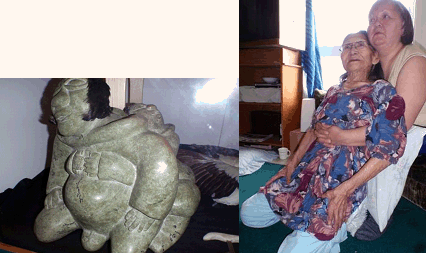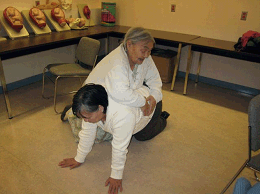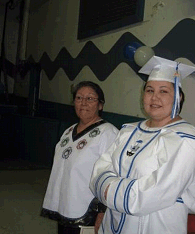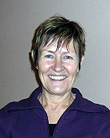Context
An emerging issue in Canadian maternity care is the experience of Nunavut mothers1. In a survey of women giving birth in Canada prior to the 2006 census, it was reported that mothers residing in Nunavut, a territory consisting of a major portion of Northern Canada and the Canadian Arctic, were more likely (62% vs 2.5% throughout Canada) to travel more than 100 km to give birth. They were less satisfied with their maternity experiences and reported having less information than other women living in Canada about pregnancy related topics. They were also more likely to smoke and to experience abuse and postnatal depression1.
The integration of midwives as primary providers of Canadian maternity care is generating increased interest. There are two important reasons for the proliferation of provincial and territorial midwifery legislation. First, there is a dearth of maternity care providers in Canada, particularly in rural areas2. This has led the Society of Gynaecologists and Obstetricians of Canada to support the ongoing integration of midwives as primary maternity care providers in a publicly funded system3,4. Second, a national survey of maternity experiences showed that if the primary birth attendant for women who gave birth in Canada was a midwife, they were more likely to attend prenatal classes, to be 'very positive' about their experience and 'very satisfied' with information that they received1.
Issues
Historically, Nunavut women were attended in their communities by family members and community experts who were known as traditional midwives. These family members who were usually but not always women, acquired their expertise through the observation of skills passed down from generation to generation and they provided support and caring to Nunavut women in small subsistence-level communities. Their ability to practice was suppressed after the middle of the 20th century with the organization of Inuit into larger communities that included southern institutions such as trading centres, health centres and schools. This practice interrupted traditional learning styles, including the generational transmission of birthing knowledge that since antiquity had served the Inuit population. Confidence in traditional practices and customs began to erode as birthing in the community became less frequent5.
Except in Iqaluit, the only Nunavut community with a hospital, and Rankin Inlet, a community with a long standing birth centre, Inuit women who live in remote locations are required to leave their communities and travel either to Iqaluit or a larger centre (eg Winnipeg, Montreal, Ottawa, Yellowknife) at 36 weeks gestation to await the birth of their baby. Women are then obliged to birth in the absence of supportive relationships existing within their community. They are isolated from partners and children for extended periods, thus disrupting family life, sometimes irrevocably.
Leaving one's community during a life transitioning event has been expressed by Inuit families as having lasting psychological implications or, more specifically, having 'emotional, physical and economic' impact6. The Inuit believe that bringing the birth process back into their communities via the integration of midwives is essential to the re-introduction of traditional models, complemented by modern maternity care5.
Re-introduction of midwifery in Nunavut
In 1992, the Keewatin Regional Health Board and the Government of the Northwest Territories in Canada agreed to fund a low risk birthing project in Rankin Inlet, Nunavut. The midwifery driven project began offering midwifery care in May 1993 and continued until March 1996. In the beginning, a position was identified for a traditional midwife. However, the position remained unfilled because local Inuit midwives had not practiced in the past 25-30 years and were hesitant to apply. They saw their roles as being consultants to the project rather than active midwives. The final project evaluation provided evidence that it was safe, economical and emotionally satisfying for low risk women who choose to birth in their isolated home community with skilled attendants.
A midwifery service program that provided apprenticeship training at the Rankin Inlet Health Centre commenced in 1996; however, difficulty with recruitment and retention as well as the inconsistent approach and preparation of southern midwives at the birth centre created problems. The most promising way to educate skilled midwives was deemed to involve moving responsibility for the program from the birthing centre to Nunavut Arctic College (NAC); placing midwives within a regulatory framework was seen as essential for safe and consistent practice. To accomplish this goal, registration was required for the Nunavut trained midwives. A partnership was formed between the Department of Health and Social Services and NAC to make this a reality.
With over 80% of the births in the Kivallik region taking place at the Rankin Inlet birth centre, this community-led initiative has already demonstrated 'lower than the combined rates of fetal and neonatal mortality in comparable [arctic] populations' (p. 388)7. A recent retrospective cohort of maternity care providers in Nunavik found no statistically significant differences in physician versus midwifery intrapartum outcomes with respect to perinatal mortality and other secondary measurements defined a priori7. Regarding the safety of midwifery care in remote regions, the somewhat higher but not statistically significant rate of perinatal mortality was eliminated when extremely preterm birth (a sometimes unavoidable outcome in remote communities accessed only by air) was factored out7.
The delivery of maternity care in Nunavut requires a double undertaking. Midwives must be recruited who will establish the beginnings of local maternity services that include prenatal, intrapartum and postpartum care. However, to ensure stability and sustainability of community based services, a plan to simply import midwives not native to the territory is inadequate. At the same time, the preparation of Inuit midwives within the territory is almost impossible without established midwifery services where students can be placed. This blending of non-Inuit and Inuit practioners and students makes the notion of 'cultural safety' developed by Irihapeti Ramsden, a Maori Nurse Educator8,9 essential to the successful integration of midwifery in the territory. Based on the premise that qualified nurses trained by dominant white European-based culture are ill-equipped to care for minority groups, culturally or ethnically 'different' patients are therefore at risk of having poorer healthcare experiences10. The concept of cultural safety requires healthcare providers to look inward at their own beliefs rather than evaluating the beliefs of others, understand the impact of poverty, and acknowledge the power gradient that so often exists between health professionals and those they serve, which leads to feelings of powerlessness and intimidation on the part of those being served10,11. Clearly, a midwife who is part of both Inuit and midwifery cultures is best equipped to fuse safe and culturally competent care.
Rather than encouraging professionals representing southern-dominant culture in Canada to reflect on their position of power and authority and the influence this can have within the care-giving relationship, the Inuit midwife is an insider and well aware of the influence of her culture and geographic place. She lives her life within the same context as her clients and their families12. Midwives representing a variety of cultures both within Nunavut and exterior to Nunavut who will take on roles in practice, education and policy in the Territory will need to incorporate the perspectives and culture of the Inuit people and integrate this into planning all aspects of maternity care services.
There are important considerations that need to be addressed in planning the delivery of a midwifery education program (MEP) in Nunavut. A vibrant and creative but sparsely distributed population exists within an immense geographic area. The harsh climate and dispersion of the population is reflected in small communities that are typically isolated from each other. The challenge facing Nunavut policy-makers is to provide a high level of maternity care that will serve the geographically isolated Inuit communities. There is a dearth of qualified midwives who can provide culturally appropriate, safe and evidenced based care to Nunavut families, who at the same time act as mentors, role models and teachers to midwifery students. Given the loss of traditional maternity, including midwifery practice, throughout most of the Territory by colonization or migration9, creative approaches will be needed to capture the traditions while also integrating aspects of existing MEP curricula from other regions of Canada.
Overview of midwifery education programs in Canada
There are 6 MEPs in Canada, and these are characterized by their similarities in philosophy as well as their commitment to the Canadian model of midwifery and the need to meet nationally based competencies. The philosophical cornerstones of the Canadian midwifery model includes partnership with birthing women; informed choice, including choice of birth setting; and continuity of care. While the regulation of midwives is a provincial/territorial matter, there are mechanisms in place to facilitate registration across provinces/territories so that midwives who are regulated in one area can meet regulatory standards throughout Canada. The programs are also shaped by their diversity with respect to meeting unique linguistic, geographic and cultural needs of the provincial/territorial Midwifery Acts, as well as the populations served and the midwifery students themselves.
Five direct-entry midwifery programs are available in the provinces of Ontario (from a consortium of the 3 universities, McMaster, Ryerson and Laurentian), Québec, British Columbia, Manitoba and Nunavut; and 2 bridging programs are in place to assess whether midwives trained internationally or through apprenticeships meet standards set by the Canadian Midwifery Regulators Consortium. There are currently 2 programs in Canada that focus on traditional midwifery with the goal of returning birth to the community. The priority for midwives prepared in these programs is to meet maternity care needs in their communities and to practice in traditional and culturally sensitive ways5. While MEPs were implemented relatively recently in Canada (the first in 1993), an informal apprenticship model was in place in most provinces prior to regulation and many of these midwives were successfully 'grandmothered', in that when assessed and upgraded as needed with additional educational workshops, they were able to meet provincial regulatory requirements.
Midwifery education program in Nunavut
In response to this critical need for midwives in Nunavut who meet current Canadian maternity care standards while remaining rooted in traditional knowledge and values, NAC and the Ministry of Health, Government of Nunavut are offering a layered a maternity care program that rotates to sites throughout Nunavut. The goal of the program is to prepare Nunavut midwives to merge experience, traditional knowledge, and the best available evidence to inform birthing families13. It is designed to reflect the goals, values, and ethical codes established for NAC and the territory of Nunavut. These characteristics are consistent with those of the Canadian Association of Midwives and the International Council of Midwives. The health promotion model facilitates/fosters a commitment to lifelong learning in students and encompasses specific entry-to-practice competencies established for Nunavut, within the context of Inuit values, in addition to those of the Canadian Midwifery Regulatory Consortium and the International Council of Midwives.
There are 3 possible program exits, depending on the interests, preparedness and capabilities of the student. They are:
- Maternity Care Worker (MCW) certificate, following satisfactory completion of level 1, which prepares women to assist birthing families in communities by offering support and meeting learning needs throughout the child-bearing cycle.
- Midwifery diploma, following satisfactory completion of levels 1-3, which prepares students to meet all midwifery competencies established by the Canadian Midwifery Regulatory Consortium, as well as those specific to Nunavut.
- Bachelor of Health Science (BHSc) in Midwifery, following satisfactory completion of levels 1-4, which prepares students to become more formal midwifery leaders, wherever they practice
The program at NAC integrates the theoretical and practice competencies of other midwifery programmes in Canada within the cultural and geographical context of Nunavut. The first students were accepted in 2005 and were instructed and mentored in their home community. Admission requirements typically include knowledge of Inuktitut. Prior to preparing students for the Canadian Midwifery Regulatory Exam (CMRE) and to assess their clinical skills and theoretical knowledge with respect to Canadian standards, the first students were sent to Ryerson University for assessments and tailored student program planning. Subject matter included anatomy and physiology, pharmacology and maternity care management in combination with Inuit traditional midwives' and Elders' long-standing practice of helping pregnant and birthing women. Figures 1 and 2 show a traditional Inuit midwife demonstrating birthing techniques.

Figure 1: (Left) Nunavut sculpture 'Woman Giving Birth', 1968, by Elijah Michael (b. 1929, d. 2008) of Kimmirut, collection of the Nunatta Sunakkutaangit Museum, Iqaluit. Permission to reproduce the photograph of sculpture was granted by Brian Lunger Manager/Curator, Nunatta Sunakkutaangit Museum. (Right) Traditional midwife Orsoralik Ottokie, Elder of Dorset Bay, performing a traditional demonstration of fundal pressure on Natsiq Kango. Orsoralik Ottokie passed away at the end of March 2010 and this image is a tribute to her. Permission to reproduce the photograph was granted by Natsiq Kango, Qapik and Orsoralik Ottokie.

Figure 2: Traditional midwife Qapik Attaqutsiak demonstrates the traditional practice for birthing the placenta on her daughter-in-law, Natsiq Kango. Permission granted to reproduce the photograph was granted by Natsiq Kango and Qapik Attaqutsiak.
Students entering the program have diverse educational backgrounds. Some have minimal secondary education while others have post-secondary experience. The common bond is a passion for supporting women and reconnecting birthing with day-to-day Inuit culture. Whether the student completes only level 1 (MCW) or goes on to obtain a baccalaureate degree, she is and will be an integral part of returning birth to family and community in Nunavut.
While the competencies outlined by the Canadian Midwifery Regulators Consortium for any midwife practicing in Canada shape the curriculum, an equally important component is built from the ongoing consultation within the Territory. The first students enrolled in the program have shown that they have very strong ties to their communities and to the birthing women they serve. They have also indicated that any requirement to be away from their community for extended periods was difficult. They reflected on their deeply rooted traditions and northern lifestyle while studying 'abroad'. The blending of what is traditional with a western biomedical context is part of the overall approach to curriculum. Students can then identify an institutional change from 'being them' to 'being us'. Walker and colleagues describe this process as 'the cultural safety zone which begins with cultural awareness and ends with cultural integration at an institutional level' (p.14)10. The challenge of looking 'the same but different' and 'different but the same' is at the heart of the ongoing birthing of this new and creative program.
The sources of knowledge used in the educational process include:
- Experience and judgement of: (i) midwives; (ii) other healthcare providers, including traditional midwives, physicians, and nurses; and (iii) Elders.
- Formal research from:
- Peer reviewed sources including journals, dissertations and conference proceedings
- Health databases created by community, territorial and federal governments
- Current textbooks and online resources
- The voices of the women who have traditionally received or given midwifery care, women who currently receive or would like to receive care from midwives.
- Peer reviewed sources including journals, dissertations and conference proceedings
Becoming a midwife is not a matter of memorizing or emulating particular facts and practices. Central to an approach to midwifery that has both traditional and contemporary influences is the belief that care must be appropriate to the particulars of each woman. Students learn to be critical, reflective and open throughout all their learning experiences. Instructors must take care not to ask students to adopt the 'habits' of health provider mentors without giving them an opportunity to question the origins and effectiveness of mentors' practices. In interpreting evidence, students will critically appraise the rigor of quantitative and qualitative research designs of individual studies and systematic reviews. A comprehensive understanding of Inuit and personal values and beliefs around pregnancy, birthing, and maternal/newborn must be sought.
Multi-layered education
Early in 2009, the exploration of the possibility of a partnership with the MEP at Laurentian University was initiated. Laurentian is a small university with a research and education track record in rural and northern health. Some members of the midwifery faculty have midwifery practice experience in Nunavut and continue to remain connected to midwifery services in Rankin Inlet and the Kivalliq Region. Elements of the Laurentian program are offered by distance technology to their students when in placements throughout the province, and students are often encouraged and seek out a northern and rural clinical practicum. An innovative virtual case study project has recently been added to the curriculum. The virtual case study brings real-life practice situations to the student regardless of her location. She is able to follow the management of a particular situation and learn the consequences of her decisions in a way that may not be achieved in real-life practice (because she may never encounter the situation or will be prevented from following through with decisions that could have grave consequences)14. Some of the case studies already have an Arctic context, and more will be developed as Inuit midwives join in as the authors and story tellers of interesting practice situations.
Thus, the idea of including students in Nunavut is not so farfetched. In fact, a piloted virtual classroom between a Laurentian University MEP instructor and two senior students in Rankin Inlet was well received and proved to be successful. The instructor and students spent almost 1 year in weekly tutorials covering educational components traditional to the final year in midwifery education, including maternal and newborn complications and maternity care management. Both senior students successfully completed their CMREs this fall and are now practicing in Rankin Inlet as the first graduates in their program and the first registered Inuit midwives (Fig3).

Figure 3: Midwives Nowyah Williams (Honorary Diploma) and Rachel Jones (Diploma). Permission to use photograph granted by Nowyah Williams and Rachel Jones.
Students are currently enrolled in various stages of the NAC midwifery program and, therefore, Laurentian University must be flexible in bridging interested candidates at multiple stages within the Laurentian curriculum. Laurentian supports and anticipates working with NAC on a student-by-student basis, however the exploration of possible entrance points into the Laurentian program are already being explored. In all cases, Laurentian approaches their relationship with NAC students as lending support and mentorship to their existing programming and facilitation of achieving a baccalaureate in health sciences in midwifery.
Models being developed involve grouping existing curricula to complement appropriate information students will learn at NAC. The student will connect with and join her Laurentian peers in core midwifery courses, but flexibility regarding other university curricula will be essential so as not to create course overload. Although students will be encouraged to follow their peers throughout the core midwifery courses, the timeline of 4 years offers them flexibility. During that time, students will be exposed to a strong support network with other midwifery students and the larger maternity care community. Similarly, students who complete the diploma program and have already met standards set by the Canadian Midwifery Regulatory Consortium may also opt to enroll at Laurentian University and complete the non-clinical requirements via distance education at an appropriate pace.
The first opportunity to 'test' the fit of this potential partnership is taking place in the 2009 fall term. An NAC student attended Sudbury for 3 weeks to participate in 2 intensive courses in order to meet peers and to experience midwifery practice in Ontario. Back in Nunavut, she joined the third year class at Laurentian in their online courses and undertook the same community interprofessional placement courses. In addition to the clinical component of her final year, this student will join her Laurentian peers in the online tutorial component thus synthesizing her experiential and academic teachings. Plans to ensure a strong midwifery focus for her final year of studies, primarily in placement, are underway.
In the case of this student, and for many potential future students, the challenge is in finding 'just right' placement opportunities within the student's home community. Every community in Nunavut provides prenatal care to women before they relocate for birth; therefore, some components of prenatal and postpartum care can be captured at home. While students in Rankin Inlet, and soon in Cambridge Bay, have the opportunity to work and learn beside midwives, there are currently no other established midwifery services in Nunavut. In her brief exposure to midwifery practice in Sudbury, the student mentioned recognized that only some of what it takes to be a midwife is learning the 'how to' of 'measuring and catching'. One learns maternity care by working with various health professionals; however, one learns to be a midwife by working with midwives. When there are no existing midwives in the community and lengthy relocations for placements are not possible, other creative approaches are needed.
Lessons learned
Laurentian University has successfully supported NAC and Nunavut in its growth of faculty and registered midwives. Further potential Laurentian contribution is in capacity building; providing faculty to Nunavut for brief intensive periods to deliver course material while simultaneously role modeling midwifery practices such as informed choice and woman centered care. The Laurentian midwifery program complements the rich cultural curriculum provided by NAC and has the potential to create an atmosphere where the student can explore and practice the concepts of combining community and distinctly Inuit-based culturally appropriate care with the framework of Canadian maternity care.
The experience of the re-introduction of midwifery in Nunavik supports the obvious benefits to Nunavut families of returning birth to their communities. The challenges for midwives are to provide culturally safe and appropriate, consistent and continuous maternity services to families in remote and isolated communities. The community based MEP developed by NAC and enhanced through partnership with Laurentian University is very much a 'work-in-progress' but already Inuit women are successfully accepting the challenges of meeting Canadian midwifery standards while understanding and implementing the important cultural maternity practices of those traditional midwives and Elders who came before them.
Acknowledgement
Many people participated in making the program a reality, some of the early ones include Nowyah Williams, Joyce England, Sharyne Fraser, Kay Matthews and Josee Nolet. Special thanks are extended to Holliday Tyson the International Midwifery Pre-registration Program Director of Ryerson University, who designed a special program for the authors' students. The authors also acknowledge the editorial skills of Jean Chaw-Kant, MSc, in preparing this manuscript.
References
1. Public Health Agency of Canada. What Mothers Say: The Canadian Maternity Experiences Survey. (Online) 2009. Available: http://www.phac-aspc.gc.ca/rhs-ssg/pdf/survey-eng.pdf (Accessed Sept 9 2009).
2. Busing N. Managing physician shortages: we are not doing enough. Canadian Medical Association Journal 2007; 176(8): 1057.
3. Society of Obstetricians and Gynaecologists of Canada. Policy Statement on Midwifery. Journal of Obstetrics and Gynaecology Canada 2003; 25(3): 239.
4. Davis DB. Planning for the future. Journal of Obstetrics and Gynaecology Canada 2008; 28(9): 763-785.
5. Van Wagner V, Epoo B, Nastapoka J, Harney E. Reclaiming birth, health, and community: midwifery in the Inuit villages of Nunavik, Canada. Journal of Midwifery & Women's Health 2007; 52(4): 384-391.
6. Chamberlain M, Barclay K. Psychosocial costs of transferring indigenous women from their community for birth. Midwifery 2000; 16(2): 116-122.
7. Simonet F, Wilkins R, Labranche E, Smylie J, Heaman M, Martens P et al. Primary birthing attendants and birth outcomes in remote Inuit communities, a natural 'experiment' in Nunavik, Canada. Journal of Epidemiology & Community Health 2009; 63(7): 546-551.
8. Papps E, Ramsden I. Cultural safety in nursing: the New Zealand experience. International Journal for Quality in Healthcare 1996; 8: 491-497.
9. Wepa D (Ed.). Cultural Safety in Aotearoa New Zealand. Wellington: Pearson Education, 2005
10. Walker R, Cromarty H, Kelly L, St Pierre-Hansen N. Achieving cultural safety in Aboriginal health services: implementation of a cross-cultural safety model in a hospital setting. Diversity in Health Care 2009; 6: 11-22.
11. Kruske S, Kildea S, Barclay L. Cultural safety and maternity care for Aboriginal and Torres Strait Islander Australians. Women and Birth 2006; 19(3): 73-77.
12. Pairman S. Midwifery partnership: working with women. In: LA Page, R McCandlish (Eds). The new midwifery. Science and sensitivity in practice, 2nd edn. London: Churchill Livingstone Elsevier, 2006.
13. O'Brien B, Gafvels K, Williams N, Sommerfeldt S, Siksik C. Meeting the needs of Nunavut families: a community-based midwifery education program. Canadian Association of Midwives 8th Annual General Meeting; 12-14 November 2008; Québec, QC; and updated for Job Fair, Cambridge Bay; 12-14 February 2010. Poster presentation.
14. The PINE Project. Pathways for interactive narrative education. (Online) 2009. Available: http://142.51.75.17/pine/index.asp?s=midwifery&q=collection (Accessed 12 April 2010).





